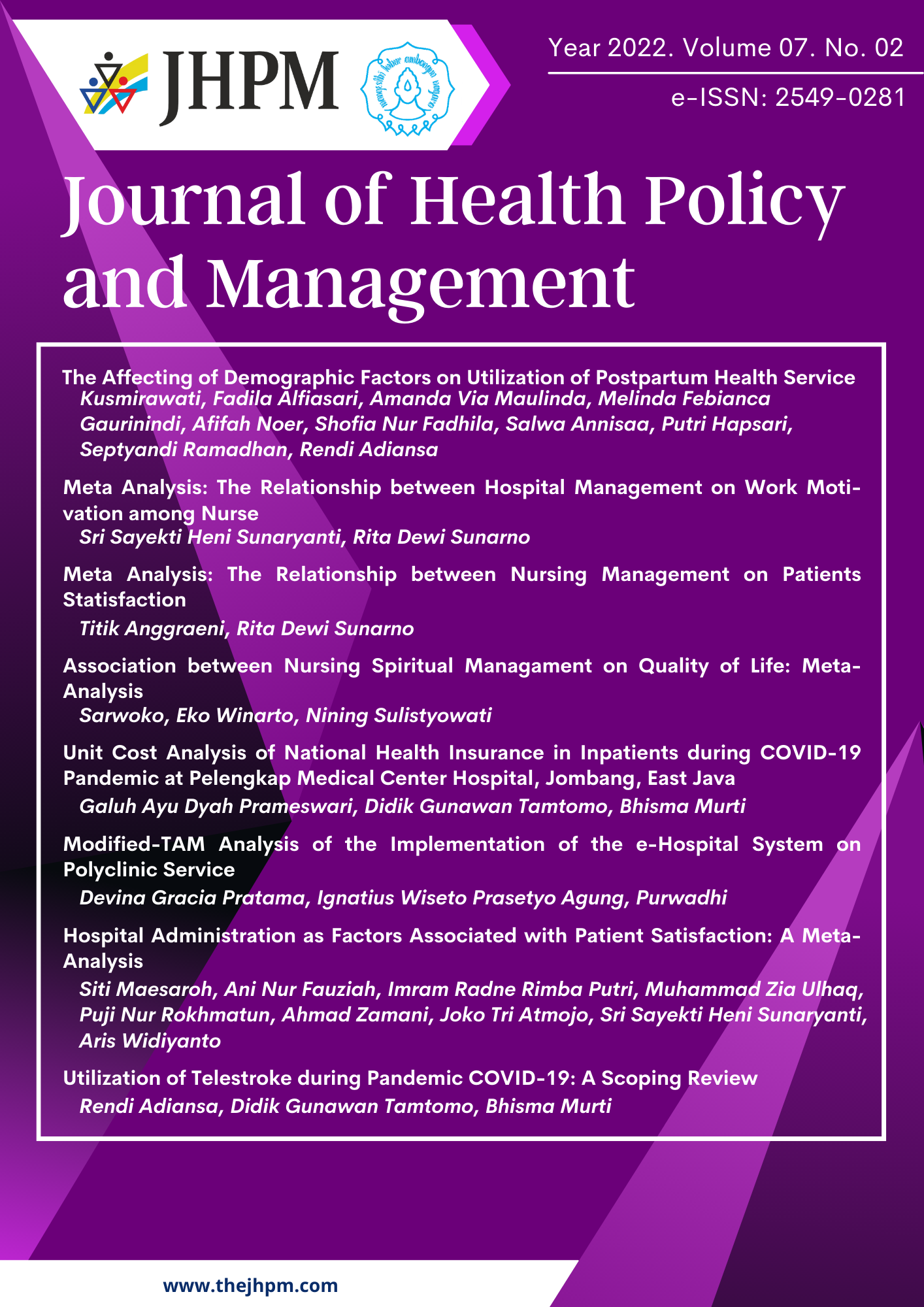Hospital Administration as Factors Associated with Patient Satisfaction: A Meta-Analysis
Abstract
Background: Maintaining hospital quality is the most important thing to consider in hospital service indicators. Patient satisfaction is one of the important factors in maintaining hospital quality. This study aimed to analyzed the associated between hospital administration with patient satisfaction.
Subjects and Method: This study is a meta-analysis with PICO, population: patients. Intervention: good hospital administration. Comparison: poor hospital administration. Outcome: patients’ satisfaction. The articles used in this study were obtained from three databases, namely Google Scholar, Pubmed, and Science Direct. Keywords to search for articles are “Hospital Administration” OR “Good Administration” OR “Hospital Services” AND “Patient Satisfaction” OR “Satisfaction” AND “Multivariate”. Articles included are full-text English from 2009 to 2021. Articles were selected using a PRISMA flow diagram. Articles were analyzed using the Review Manager 5.3 application.
Results: A total of 7 cross-sectional study articles from Asia (China), Europe (Germany), and Africa (Ethiophia) were reviewed in the meta-analysis. Based on the results of the analysis, it was found that good hospital administration has the possibility to increase patient satisfaction 3.58 times compared with poor hospital administration (aOR= 3.58; 95% CI= 2.36 to 5.42; p<0.001) and the results were statistically significant.
Conclusion: Hospital administration associated with patients statisfaction.
Keywords: hospital, hospital administration, patient statisfaction, inpatients.
Correspondence: Siti Maesaroh. School of Health Sciences Mamba’ul Ulum Surakarta. Jl. Ringroad Utara, Mojosongo, Jebres, Surakarta, Central Java, Indonesia. Email: maesarohsiti70@gmail.com. Mobile: +62 813-9386-7942.
Journal of Health Policy and Management (2022), 07(03): 227-334
https://doi.org/10.26911/thejhpm.2022.07.03.07
References
Akbar PS, Adriani RB, Murti, B (2017). The Influence of Personal Factors of the Patient, Doctor, Payment Method and Type of Class to the Quality and Satisfaction of Inpatient Care Services in Dr. Moewardi Hospital Surakarta. J. Health Policy Manag, 02(01),1–15. doi:10.26911/thejhpm.2017.01.02.01
Banakhar MA (2018). Nurses’ Work Motivation and the Factors Affecting It: A Scoping Review. doi: 10.15344/23944978/2018/277
Desta H, Berhe T, Hintsa S (2018). Assessment of patients’ satisfaction and associated factors among outpatients received mental health services at public hospitals of Mekelle Town, northern Ethiopia. Int J Ment Health Syst, 12, 38. doi: 10.1186/s130330180217z
Fang J, Liu L, Fang P (2019). What is the most important factor affecting patient satisfaction – a study based on gamma coefficient. Patient Preference and Adherence, 13, 515. doi: 10.2147/PPA.S197015
Handayani RT, Kuntari S, Darmayanti AT, Widiyanto A, Atmojo JT (2020). Factors Causing Stress in Health and Community When the Covid19 Pandemic. J. Kep. Jiwa, 8(3), 353–360. doi: 10.26714/JKJ.8.3.2020.353360
Kim CE, Shin JS, Lee J, Lee YJ, Kim M, Choi A, Park KB, et al. (2017). Quality of medical service, patient satisfaction and loyalty with a focus on interpersonalbased medical service encounters and treatment effectiveness: a crosssectional multicenter study of complementary and alternative medicine (CAM) hospitals. BMC Complementary and Alternative Medicine, 17(1). doi: 10.1186/S1290601716916
Krishnasamy M, Wilkie E, Haviland J (2001). Lung cancer health care needs assessment: patients’ and informal carers’ responses to a national mail questionnaire survey. Palliative Medicine, 15(3), 213–227. doi: 10.1191/026921601678576202
Meo MY (2022). Pengembangan Sistem Informasi Manajemen Keperawatan Dengan Integrated Clinical Pathway Untuk Meningkatkan Kualitas Pelayanan. J. Manaj. Kep. Retrieved July 10, 2022.
Siska T (2013). FaktorFaktor Risiko Kejadian Pneumonia Pada Balita Di Wilayah Kerja Puskesmas Kedungmundu Kota Semarang Tahun 2013. Retrieved July 10, 2022
Teklemariam Z, Mekonnen A, Kedir H, Kabew G (2013). Clients and clinician satisfaction with laboratory services at selected government hospitals in eastern Ethiopia. BMC Research Notes, 6(1), 1–7. doi: 10.1186/17560500615/TABLES/4
Wendimagegn NF, Bezuidenhout MC (2019). Integrating promotive, preventive, and curative health care services at hospitals and health centers in Addis Ababa, Ethiopia. J Multidiscip Healthcare. 12, 243. doi: 10.2147/JMDH.S193370
Widiyanto A, Fajriah AS, Atmojo JT, Handayani RT, Kurniavie LE (2020). The Effect of Social Media Exposure on Depression and Anxiety Disorders in Facing Covid19 Pandemic. European Eur. J. Mol. Clin. Med, 7(5), 942–950.
Widiyanto A, Peristiowati Y, Ellina AD, Pradana KA, Mubarok AS, Atmojo JT (2021). View of Potensi Program Telemedicine pada Kualitas Pelayanan Kesehatan di Intensive Care Unit. J. Gawat Darurat. 3(1), 1120.
Wu Q, Amporfro DA, Boah M, Yingqi S, Cheteu WTM, Zhao M, NgoNkondjock VR (2021). Patients satisfaction with healthcare delivery in Ghana. BMC Health Services Research, 21(1), 1–13. doi: 10.1186/S12913021067175/figures/1
Zarei A, Arab M, Froushani AR, Rashidian A, Tabatabaei SMG (2012). Service quality of private hospitals: The Iranian Patients perspective. BMC Health Services Research, 12(1), 1–7. doi: 10.1186/147269631231/tables/2
Abbas RM, Carrol N, Richardson I (2018). In Technology We Trust : Extending TAM from Healthcare Technology Perspective. International Conference on Healthcare Informatics. doi: 10.1109/ICHI.2018.00051.
Gagnon MP, Ghandour E, Talla PK, Simonyan D, Godin G, Labrecque M, Ouimet M, et al (2014). Electronic health record acceptance by physicians: testing an integrated theoretical model. J. Biomed. Inform. 48: 17–27. doi: 10.1016/j.jbi.2013.10.010.
Livinus V, Adhikara MFA, Kusumapradja R (2021). Hospital Management Information System Usefulnes in The Health Service Industry at Indonesia: Mandatory or Voluntary JMM. 10(1): 112.doi: 10.18196/jmmr.v10i1.10296.






